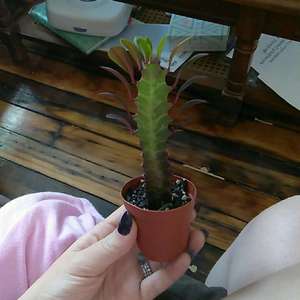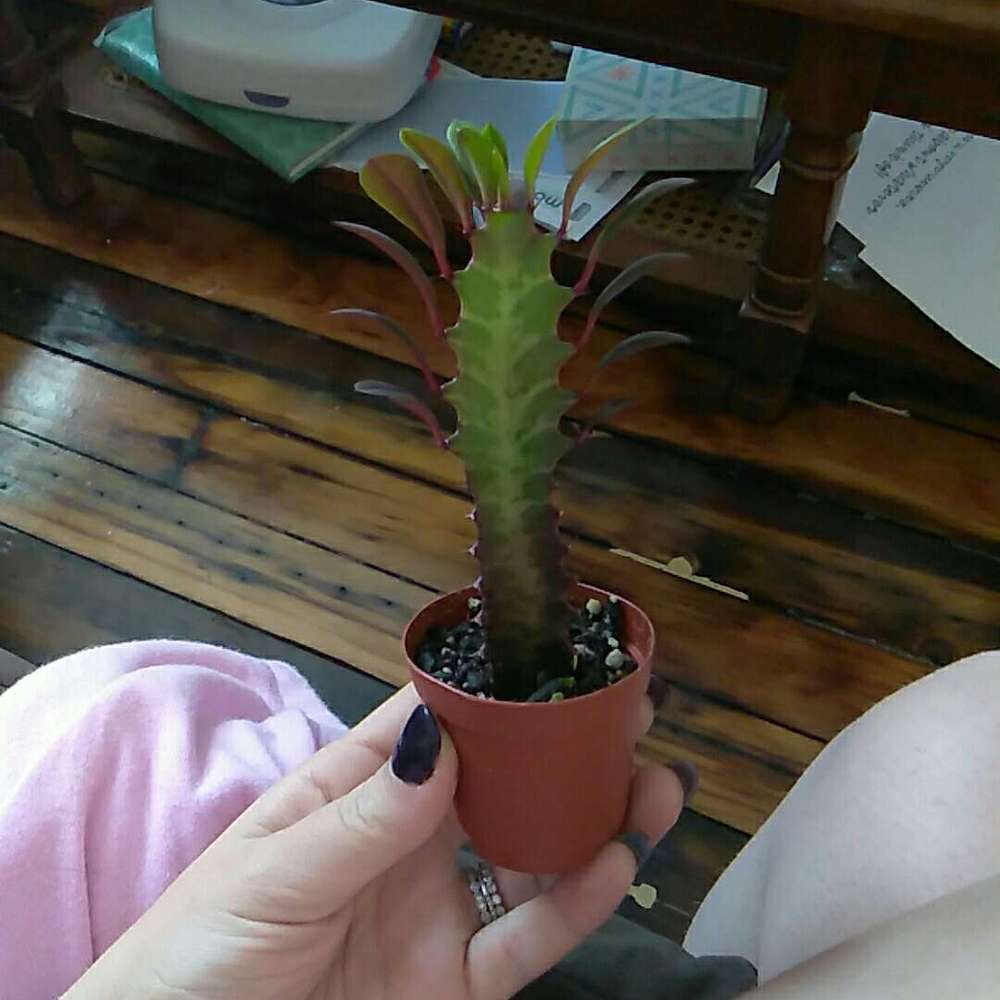植物经验
详细说明
1
Give your African milk tree all the bright light possible. While this plant requires at least one-half day of direct sun each day, it will tolerate several hours of partial sun if necessary. If you must grow it indoors, keep it near a sunny window in a room with good air circulation.
2
Keep this plant in a warm location where the temperature never dips below 50 degrees Fahrenheit overnight. If your African milk tree is primarily an indoor specimen, move it to a sunny spot outside when sustained temperatures are above 55 degrees Fahrenheit.
3
Grow your containerized milk tree in a clay pot, which will allow the planting medium to dry out quickly and go a long way toward preventing rot. Create a well-draining potting soil with one part coarse perlite and three parts peat moss.
4
Water African milk tree thoroughly when the soil surface feels dry to the touch throughout the growing season. Evenly moisten the surface of the soil, but don’t water so much that it’s soggy or wet. Allow it to dry out completely between waterings. Water the plant during winter dormancy only when the top 1 inch of soil is completely dry. If you’re in doubt, err on the side of caution and don’t water this drought-tolerant succulent.
5
Feed the African milk tree 2 or 3 times monthly throughout the growing season, from early April through early October. Use an all-purpose 20-20-20 fertilizer or a cactus and succulent preparation. Follow the packaging instructions. Don’t fertilize this plant when it’s not actively growing.
6
Repot your African milk tree once each summer between June and July, when it’s growing most actively. Plants use up the nutrients in the small soil volumes in pots quickly. Wear heavy gloves when you handle this Euphorbia. If the specimen is large, get someone to help you with holding the pot while you remove the plant from it. Replace the soil to refresh your milk tree, contribute to its overall good health and help it ward off disease. Step the plant up a pot size and use a mix of three parts peat moss and one part coarse perlite. Give the milk tree two weeks to settle into its new soil before you resume watering and fertilizing.
7
Examine the milk tree daily for signs of disease and pest issues. While desert plants such as these succulents are relatively resistant and such problems are rare, they do occur occasionally. These plants may be attacked by black stem or basal rot, mealy bugs or red spider mites. Scrutinize all surfaces of the plant weekly with a strong magnifying glass to identify tiny pests.
8
Inspect the plant for signs of black stem rot, sometimes known as basal rot. It may appear as dark, corky, gray or brown areas anywhere on the stems, and is particularly prevalent near the plant’s base. This is typically a fungal attack caused by prolonged or repeated exposure to wet soil or by cold, damp growing conditions. Rot is incurable, but it’s sometimes possible to save the plant. Sterilize a sharp knife with denatured alcohol. Cut out the infected area and take a wide margin of healthy-looking tissue with it. Paint the wound with a systemic plant fungicide or dust it with sulfur powder. Follow the manufacturer’s recommendations. Wrap the diseased plant material tightly in a plastic bag and dispose of it in the trash. Don’t add it to the compost heap.
9
Monitor this plant for mealy bugs. While these pests don’t cause much harm to cacti and succulents, they can introduce infections that may spread to more susceptible foliage plants. Look for little fluffy white balls or sticky honeydew at the base and on the spines of the African milk tree. Peek up under the rim of the pot. Take the plant outside and give all surfaces a hard spray with the garden hose to dislodge the pests. Allow the milk tree to dry completely. Dab any remaining mealy bugs with a cotton swab soaked in denatured alcohol, which will kill them on contact. Treat the plant with a contact insecticide labeled for mealy bugs. Follow the packaging instructions carefully.
10
Check for the presence of red spider mites. While they’re microscopic in size, you can observe evidence of their habitation readily. Look for a scattering of little brown dots on the plant. These indicate scarring where tissue damage is beginning, and the areas often appear to be webbed. Spray the plant thoroughly with the garden hose and allow it to dry completely. Treat it with a miticide labeled for red spider mites. Follow the manufacturer’s instructions.
Give your African milk tree all the bright light possible. While this plant requires at least one-half day of direct sun each day, it will tolerate several hours of partial sun if necessary. If you must grow it indoors, keep it near a sunny window in a room with good air circulation.
2
Keep this plant in a warm location where the temperature never dips below 50 degrees Fahrenheit overnight. If your African milk tree is primarily an indoor specimen, move it to a sunny spot outside when sustained temperatures are above 55 degrees Fahrenheit.
3
Grow your containerized milk tree in a clay pot, which will allow the planting medium to dry out quickly and go a long way toward preventing rot. Create a well-draining potting soil with one part coarse perlite and three parts peat moss.
4
Water African milk tree thoroughly when the soil surface feels dry to the touch throughout the growing season. Evenly moisten the surface of the soil, but don’t water so much that it’s soggy or wet. Allow it to dry out completely between waterings. Water the plant during winter dormancy only when the top 1 inch of soil is completely dry. If you’re in doubt, err on the side of caution and don’t water this drought-tolerant succulent.
5
Feed the African milk tree 2 or 3 times monthly throughout the growing season, from early April through early October. Use an all-purpose 20-20-20 fertilizer or a cactus and succulent preparation. Follow the packaging instructions. Don’t fertilize this plant when it’s not actively growing.
6
Repot your African milk tree once each summer between June and July, when it’s growing most actively. Plants use up the nutrients in the small soil volumes in pots quickly. Wear heavy gloves when you handle this Euphorbia. If the specimen is large, get someone to help you with holding the pot while you remove the plant from it. Replace the soil to refresh your milk tree, contribute to its overall good health and help it ward off disease. Step the plant up a pot size and use a mix of three parts peat moss and one part coarse perlite. Give the milk tree two weeks to settle into its new soil before you resume watering and fertilizing.
7
Examine the milk tree daily for signs of disease and pest issues. While desert plants such as these succulents are relatively resistant and such problems are rare, they do occur occasionally. These plants may be attacked by black stem or basal rot, mealy bugs or red spider mites. Scrutinize all surfaces of the plant weekly with a strong magnifying glass to identify tiny pests.
8
Inspect the plant for signs of black stem rot, sometimes known as basal rot. It may appear as dark, corky, gray or brown areas anywhere on the stems, and is particularly prevalent near the plant’s base. This is typically a fungal attack caused by prolonged or repeated exposure to wet soil or by cold, damp growing conditions. Rot is incurable, but it’s sometimes possible to save the plant. Sterilize a sharp knife with denatured alcohol. Cut out the infected area and take a wide margin of healthy-looking tissue with it. Paint the wound with a systemic plant fungicide or dust it with sulfur powder. Follow the manufacturer’s recommendations. Wrap the diseased plant material tightly in a plastic bag and dispose of it in the trash. Don’t add it to the compost heap.
9
Monitor this plant for mealy bugs. While these pests don’t cause much harm to cacti and succulents, they can introduce infections that may spread to more susceptible foliage plants. Look for little fluffy white balls or sticky honeydew at the base and on the spines of the African milk tree. Peek up under the rim of the pot. Take the plant outside and give all surfaces a hard spray with the garden hose to dislodge the pests. Allow the milk tree to dry completely. Dab any remaining mealy bugs with a cotton swab soaked in denatured alcohol, which will kill them on contact. Treat the plant with a contact insecticide labeled for mealy bugs. Follow the packaging instructions carefully.
10
Check for the presence of red spider mites. While they’re microscopic in size, you can observe evidence of their habitation readily. Look for a scattering of little brown dots on the plant. These indicate scarring where tissue damage is beginning, and the areas often appear to be webbed. Spray the plant thoroughly with the garden hose and allow it to dry completely. Treat it with a miticide labeled for red spider mites. Follow the manufacturer’s instructions.
花相册 (1)

Jessica Doucette Alas
2018年06月21日

This is my first growing diary.







